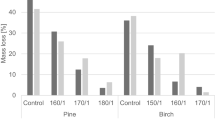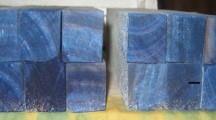Abstract
Copper ethanolamine preservatives are one of the most important solutions for wood preservation. As copper itself can not ensure sufficient protection against wood destroying organisms we combine it with other co-biocides like quaternary ammonium compounds, azoles and/or boron. Influence of different boron compounds and octanoic acid on copper fixation as well as performance of spruce wood impregnated with different copper/ethanolamine/boron based aqueous solutions is described in this paper. Copper fixation was determined according to the modified ENV 1250 (1994) standard method, while performance against Antrodia vaillantii, Gloeophyllum trabeum and Trametes versicolor was tested according to the mini block procedure. The results showed that addition of boron increases copper leaching, but on the contrary improves performance against wood decay fungi. On the other hand, addition of octanoic acid improves copper fixation, and slightly decreases resistance against copper tolerant fungi.
Zusammenfassung
Kupferethanolamin ist eine der wichtigsten Substanzen für Holzschutzmittel. Da Kupfer alleine keinen ausreichenden Schutz gegen Holz zerstörende Organismen bietet, wird es mit anderen Bioziden, wie zum Beispiel quaternären Ammoniumverbindungen, Pyrrol und/oder Bor, kombiniert. Diese Arbeit beschreibt den Einfluss verschiedener Borverbindungen sowie Octansäure auf die Kupferfixierung sowie das Verhalten von mit verschiedenen kupfer-/ethanolamin-/borhaltigen Lösungen imprägniertem Fichtenholz. Die Kupferfixierung wurde in Anlehnung an ENV 1250 (1994) bestimmt. Die Wirksamkeit gegen Antrodia vaillantii, Gloeophyllum trabeum und Trametes versicolor wurde mit dem “Mini-Block”-Verfahren geprüft. Dabei zeigte sich, dass der Zusatz von Bor zu einer erhöhten Kupferauswaschung führte, jedoch die Wirksamkeit gegen Holz zerstörende Pilze verbesserte. Der Zusatz von Octansäure verbesserte dagegen die Kupferfixierung, verringerte aber in geringem Umfang die fungizide Wirkung.
Similar content being viewed by others
References
Breeuwer P, deReu JC, Drocourt JL, Rombouts FM, Abee T (1997) Nonanoic acid, a fungal self-inhibitor, prevents germination of Rhizopus oligosporus sporangiospores by dissipation of the pH gradient. Appl Environ Microbiol 63:178--185
Cao J, Kamdem DP (2004) Moisture adsorption characteristics of copper-ethanolamine (Cu-EA) treated Southern yellow pine (Pinus spp.). Holzforschung 58:32--38
Claus I, Kordsachia O, Schröder N, Karstens T (2004) Monoethanolamine (MEA) pulping of beech and spruce wood for production of dissolving pulp. Holzforschung 58:573--580
EN 84 (1994) Wood preservatives -- Accelerated ageing of treated wood prior to biological testing -- Leaching procedure. European Committee for Standardization, Brussels 16
EN 113 (1989) Wood preservatives; Determination of the toxic values against wood destroying basidiomycetes cultured an agar medium. European Committee for Standardization, Brussels 14
ENV 1250 (1994) Wood preservatives -- Methods for measuring losses of active ingredients and other preservative ingredients from treated timber -- Part 2: Laboratory method for obtaining samples for analysis to measure losses by leaching into water or synthetic sea water. European Committee for Standardization, Brussels 16
Humar M, Pohleven F, Amartey SA, Šentjurc M (2004) Efficacy of CCA and Tanalith E treated pine fence to fungal decay after ten years in service. Wood Res 49:13--20
Humar M, Kalan P, Pohleven F (2005a) Influence of carboxylic acids on fixation of copper amine based preservatives. Int Res Group Wood Protect IRG/WP 05-30365, p 8
Humar M, Šentjurc M, Amartey SA, Pohleven F (2005b) Influence of acidification of CCB (Cu/Cr/B) impregnated wood on fungal copper tolerance. Chemosphere 58:743--749
Richardson BA (1993) Wood Preservation, Second edition. E&FN Spon, London Glasgow, p 226
Ruddick JNR, Xie C, Herring FG (2001) Fixation of amine copper preservatives. Part 1, Reaction of vanillin, a lignin model compound with monoethanolamine copper sulphate solution. Holzforschung 55:585--589
Schmidt EL (1984) Influence of aliphatic acids on spore germination of wood decay fungi. Int Res Group Wood Protect IRG/WP 84-2224, p 5
Zhang J, Kamdem DP (2000) Interaction of copper-amine with southern pine. Wood Fiber Sci 32:332--339
Author information
Authors and Affiliations
Corresponding author
Rights and permissions
About this article
Cite this article
Humar, M., Žlindra, D. & Pohleven, F. Improvement of fungicidal properties and copper fixation of copper-ethanolamine wood preservatives using octanoic acid and boron compounds . Holz Roh Werkst 65, 17–21 (2007). https://doi.org/10.1007/s00107-006-0118-8
Published:
Issue Date:
DOI: https://doi.org/10.1007/s00107-006-0118-8




